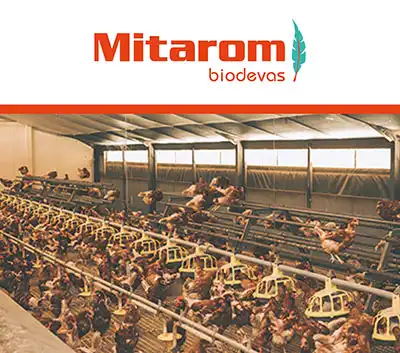Red mites in layers, the summer hit we don’t like
Red mites – those dreaded nocturnal pests – affect 83% of layer farms in Europe and cost €360 million a year, all farm types combined. With productivity losses per hen estimated at between €0.60 and €2.50 per year, this scourge deserves special attention, especially in summer when their life cycle accelerates.
A summer tsunami of mites
Summer conditions accelerate the life cycle of red mites to just eight days, with each female laying up to nine eggs per cycle.
Let’s do a quick calculation: assuming a parasite cycle of 10 days with four female eggs per cycle, that would give us a female mite population four times the size in 10 days and 64 times the size in 30 days: in other words, a tidal wave of red mites to deal with on farms.
Red mites know how to go unnoticed, tormenting laying hens discreetly at night long before they’re actually detected. Mite traps are essential to assess the extent of an infestation and to develop an action plan that combines different strategies (crawl space eradication and the use of acaricides that can be administered to hens, repellents and contact products).
A tactical and strategic approach
Effective control of red mites requires a multi-faceted approach. While chemical treatments such as Exzolt® (fluranaler) can be useful in uncontrolled situations, these products are expensive and harm the environment. However, red mites become dormant during treatment only to reappear a few months later, even at the recommended dose. It is worth keeping this treatment handy for an uncontrolled situation or using it strategically if the situation is expected to come under strong pressure. In this case, use it at the start of egg-laying to halt the start of the population explosion then switch over to the other tools: repellents and contact products. If the expected pressure is low to medium, it can be dispensed with, but the other tools are still required.
MITAROM: a trailblazer in repellents

For a more natural and sustainable solution, Biodevas Laboratoires offers MITAROM, a 100% natural supplementary feed which repels red mites while calming hens. It is non-biocidal, palatable, residue free in eggs and doesn’t affect their taste.
MITAROM is derived from plants, mainly French-produced, which are extracted using Biodevas Laboratoires’ own process. This limits their carbon footprint.
It has a low carbon footprint as it is based primarily on plants grown in France and our in-house extraction process.
Available as a solid in feed or as a liquid, MITAROM can be used in organic farming as a liquid or based on lithotamne.
It can also be concentrated to provide relevant B2B forms.
Repellent and calming effects in conventional and organic animal husbandry
MITAROM is an invaluable aid in managing onslaughts of red mites by reducing their reproduction. Instead of an immediate knockdown effect, you’ll see hungry, anaemic mites – just the right time for effective contact treatments. The calming effect of MITAROM also reduces the stress which red mite infestations cause hens.
By encouraging farmers to use chemical drugs less and together with good farming practices, MITAROM contributes to our One Health objectives.
To put a plan in place for your specific situation before the summer, contact us today by clicking here.
